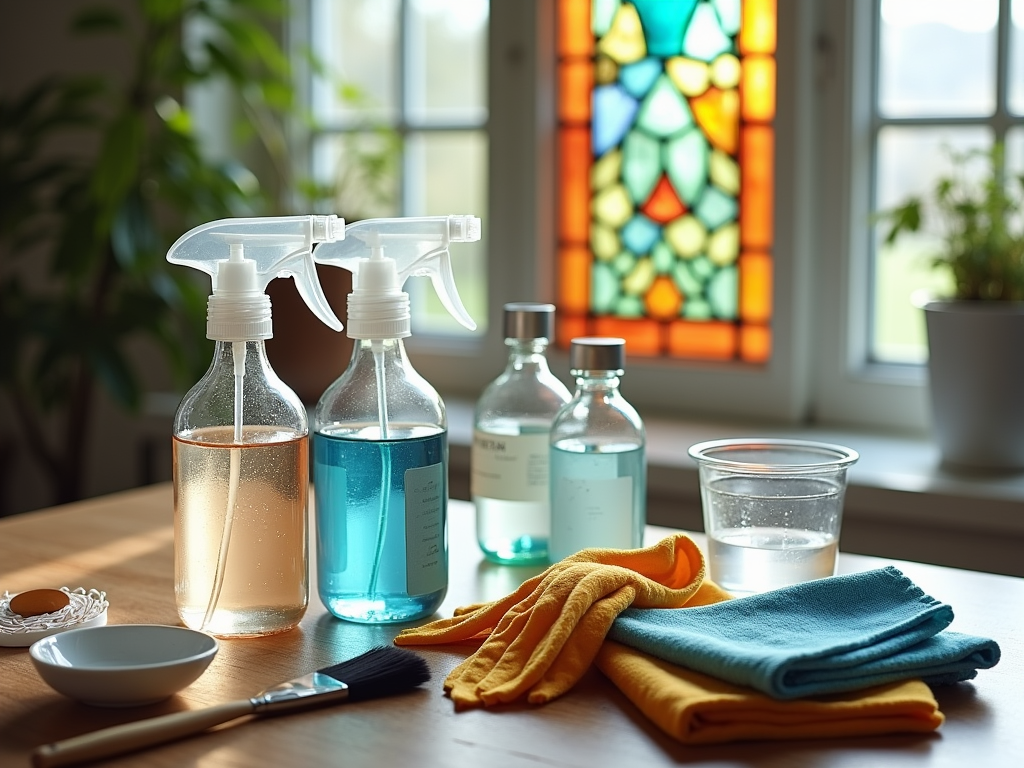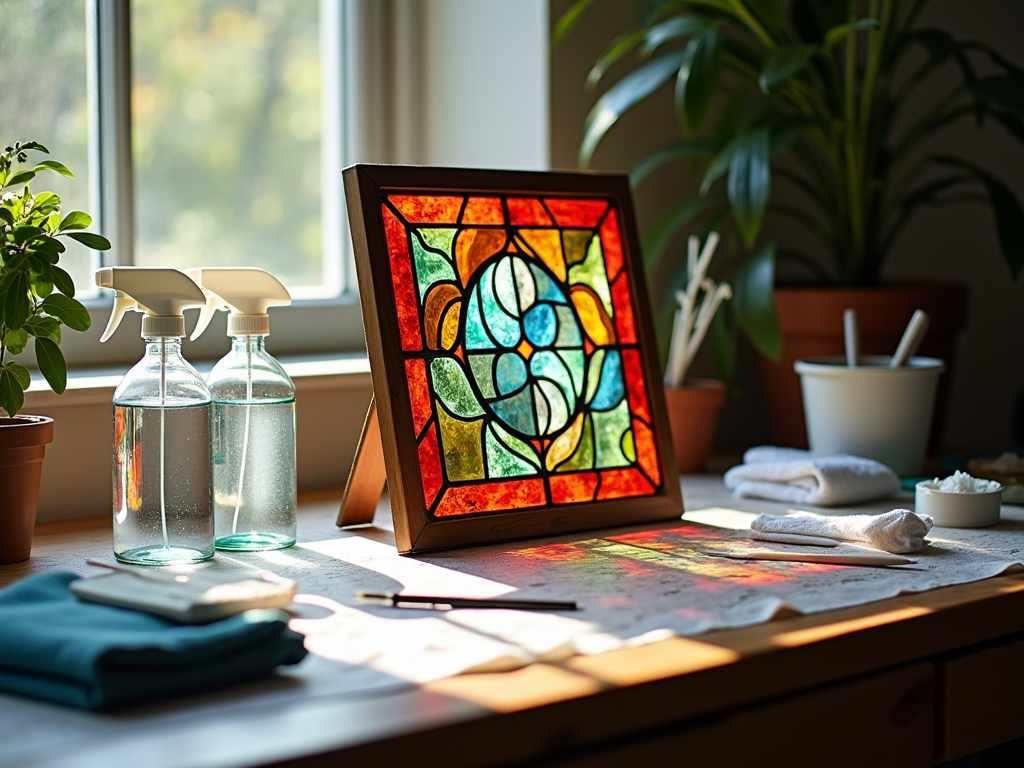
Cleaning stained glass demands precision and the right tools to keep its artistic beauty intact. By using gentle methods and appropriate products, you can preserve its charm and protect its delicate features.
Key Takeaways
- Opt for distilled water to avoid leaving minerals behind and mix it with mild dish soap to prevent harming solder joints or delicate surfaces.
- Keep microfiber cloths, isopropyl alcohol, and soft-bristled brushes handy for carefully lifting dirt, smudges, and grime without scratching.
- Using gloves and masking tape minimizes the risk of fingerprints, ensures secure handling, and prevents accidental harm.
- Steer clear of abrasive tools or strong chemicals that can lead to scratches, damage, or discoloration of the glass or its finish.
- Regularly dust, clean gently, and manage sunlight or temperature changes to preserve the timeless beauty of stained glass.
The Must-Have Tools for Cleaning Stained Glass
To safely and effectively clean stained glass, gathering the right set of tools is key. Stained glass is delicate, and improper cleaning can damage the intricate details or solder lines. Here’s a rundown of everything you’ll need and why each item matters.
Start with two spray bottles—one for your cleaning solution and the other for rinsing with distilled water. Distilled water is important because it won’t leave behind mineral residues that could build up on the glass. For your cleaning solution, use mild dish soap, but skip anything with ammonia or vinegar, as these can corrode the solder and strip the patina.
A set of microfiber cloths is essential. These won’t scratch the surface and will effectively remove dirt and grime. You’ll also want isopropyl alcohol (at least 70%) for gently tackling more stubborn smudges and fingerprints without harming the glass. For hard-to-reach spots, cotton swabs or a soft-bristled brush—like a paintbrush—are perfect.
Masking tape can protect the surrounding frame or nearby materials from accidental drips. Don’t forget gloves to keep oils from your hands off the glass. And finally, a small bucket keeps everything tidy, especially when working with water.
Always stick to gentle and non-abrasive materials. Harsh tools or cleaners can cause irreversible damage, so having the right supplies helps maintain brilliance. If you’d like even more guidance on handling fragile stained glass, learn tips in this DIY stained glass guide.

Your Step-by-Step Guide to Effortlessly Clean Stained Glass
I like to start by dusting the stained glass with a soft cloth or duster. This gets rid of any loose debris that might scratch the surface during cleaning. Once it’s clear of dust, I mix a few drops of mild dish soap into distilled water. Distilled water works wonders in preventing streaks caused by minerals.
Here’s how I clean it effectively:
- Lightly spray the solution onto the glass, keeping it away from the solder lines.
- Gently wipe the surface with a microfiber cloth, moving in a single direction. Don’t scrub—it’s not necessary and could cause damage.
For stubborn stains, I use isopropyl alcohol on a cotton swab. Once treated, I rinse the area again with distilled water and dry it completely with a second microfiber cloth. Proper drying eliminates streaks and leaves the glass flawless. More tips can be found in this guide on making stained glass.

How to Tackle Common Stains Without Damaging Stained Glass
Hard water stains are a common challenge. I’d suggest using a simple 50/50 mix of water and white vinegar. Apply it sparingly with a soft cloth, and avoid getting it onto the solder lines to prevent damage.
For paint stains, a razor blade offers precision. Work gently at an angle, and never scrape directly onto the glass to avoid scratches. If there’s leftover caulk residue, a commercial caulk remover does wonders—but always follow the product instructions closely. Sticky residue, such as labels or tape, can be tackled using isopropyl alcohol on a soft cloth.
Before using any cleaner, test a small amount in an inconspicuous area to avoid unexpected reactions. These steps help safeguard your stained glass, whether it’s a DIY creation or a treasured piece. If you’re curious about creating your own artistry, check out how to make stained glass.
Pro Tips to Extend the Life of Your Stained Glass
Keeping stained glass in top condition starts with a few smart habits. Regular dusting using a soft, lint-free cloth prevents grime from building up. Avoid any harsh chemicals—they can damage the paint or even weaken the solder holding the glass pieces together. A gentle glass cleaner made specifically for stained glass works best if a deeper clean is ever needed.
To help protect your piece, keep it out of direct sunlight and away from extreme temperature fluctuations. This cuts down on fading and prevents the glass or solder from cracking over time. For added durability, applying a protective coating can make a huge difference. Products like Krylon Stained Glass Sealer or Clarity Stained Glass Protective Coating create a barrier without dulling the colors. If you’re curious about proper techniques for making and caring for stained glass, check out how to make stained glass for helpful insights.
When to Call in the Professionals for Stained Glass Care
Sometimes, cleaning stained glass yourself isn’t enough. I recommend reaching out to professionals if the window has extensive damage, delicate details, or holds historical value. They have tools and techniques for deep cleaning, replacing broken sections, and restoring worn lead came, ensuring the piece maintains its structural integrity.
Professional care is ideal for large or intricate windows where DIY methods might skip hard-to-reach spots. For antique or valuable panels, skilled expertise prevents damage that could reduce their worth. Pricing varies between $XX and $XXX, depending on size and design complexity.
For fragile or priceless pieces, restoration ensures lasting beauty. If you’d like to explore techniques used in creating stained glass, take a look at this article on how stained glass is made. It’s fascinating to see how artistry and craftsmanship come together.

Stay Safe While Cleaning Stained Glass
I always make sure to wear a good pair of gloves when I clean stained glass. This keeps my hands safe from cuts and prevents direct contact with cleaning solutions. A well-ventilated area is key, especially if I’m working with commercial cleaners. Proper airflow avoids breathing in harmful fumes.
Another rule I follow is to never, under any circumstances, mix ammonia and bleach. Combining the two can release toxic gases, which are dangerous. It’s not worth the risk.
For leftover cleaning solutions, I take steps to dispose of them responsibly. Dumping them down the sink can harm plumbing and the environment. Instead, I follow guidelines for safe disposal. This extra step helps me clean without causing unintended damage.
For more practical cleaning tips, you might also check out how to make stained glass to better understand its durability.
Sources:
Rainbow Cleaners pamphlet on Hard Water Stain Removal
“Caring for Your Stained Glass” by Justine Dormandy
Stained Glass Association of America website article, “Maintaining Your Stained Glass Windows”
Krylon website product description for Stained Glass Sealer
Clarity website product description for Stained Glass Protective Coating
